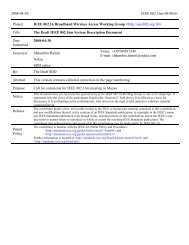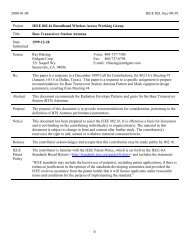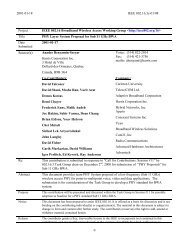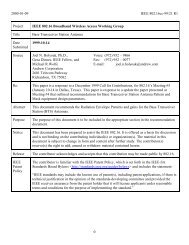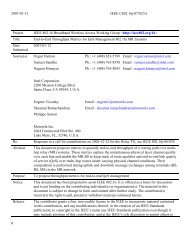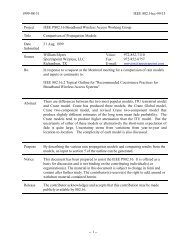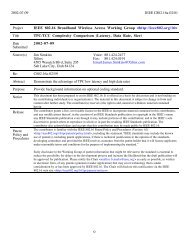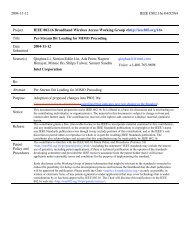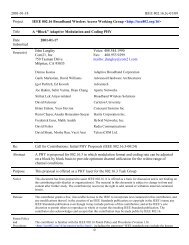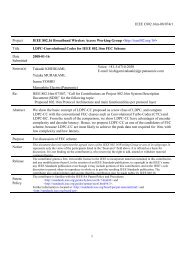802.16.1 Functional Requirements, Rev. 1 - LMSC, LAN/MAN ...
802.16.1 Functional Requirements, Rev. 1 - LMSC, LAN/MAN ...
802.16.1 Functional Requirements, Rev. 1 - LMSC, LAN/MAN ...
Create successful ePaper yourself
Turn your PDF publications into a flip-book with our unique Google optimized e-Paper software.
12345678910111213141516171819202122232425262728293031323334353637383940414243444546471999-12-17 IEEE 802.16s-99/00r1This protocol stack reference model is intended to help develop terminology, and possiblyprotocol architecture. Each of the “special” protocols above the MAC and PHY are given“convergence sub-layers.”. The convergence sub-layers [2] [17] may be necessary to:• Encapsulate PDU framing of upper layers into the native <strong>802.16.1</strong> MAC/PHY PDUs. [17]• Map an upper layer’s addresses into <strong>802.16.1</strong> addresses• Translate upper layer CoS/QoS parameters into native <strong>802.16.1</strong> MAC constructs• Adapt the asynchronous, synchronous or isochronous data pattern of the upper layer into theequivalent MAC service• Reduce the need for complex inter-working functions (IWFs) [17]For instance, in the ATM world a Transmission Convergence (TC) layer is defined for each linktype that carries ATM cells. The purpose of this layer is to delimit cells using the particular linktechnology, and to signal idle time, or insert idle ATM cells on the link. <strong>802.16.1</strong> borrows thisterminology to accommodate “special” requirements of the multiple upper layer protocols.Another assumption made in the diagram is that digital audio/video (DAV) service bypasses theMAC protocol layer and accesses the PHY layer directly. This assumption is made because theDAV multicast bearer service (see section 3.1.1) is transmitted in the downstream direction only,and does not require the main service of the MAC: channel contention (access control).The central purpose of the MAC protocol layer in <strong>802.16.1</strong> is sharing of radio channel resources.The MAC protocol defines how and when a base station or subscriber station may initiatetransmission on the channel. Since key layers above the MAC, such as ATM and STM, requireservice guarantees, the MAC protocol MUST define interfaces and procedures to provideguaranteed service to the upper layers. In the downstream direction, since only one base station ispresent, and controls its own transmission, the MAC protocol is simple. But in the upstreamdirection, if one radio channel is allocated to more than one subscriber station, the MAC protocolMUST efficiently resolve contention and bandwidth allocation. Note that the function of theMAC layer is not to provide error correction by retransmission, or automatic repeat request(ARQ). In the 802 model, those functions if necessary, are provided by the LLC layerThe PHY layer is similarly subdivided between a convergence layer and a physical mediumdependent(PMD) layer. The PMD is the “main” part of the PHY. Like the MAC convergencelayers, the PHY convergence layers adapt/map the “special” needs of the MAC and DAV servicesto generic PMD services. For instance, to best support DAV services, the PHY MAY provideTDM-based encapsulation of DAV streams in TDM MPEG-II frames [14].Further details, and finalization of the protocol reference model, SHALL be worked out by the <strong>802.16.1</strong> MAC andPHY task groups while developing the air interface interoperability standard.5 Performance and CapacityThis section addresses some issues regarding <strong>802.16.1</strong> system performance and capacity.Specifying protocols such that an <strong>802.16.1</strong> system can maintain a specified/mandated performancelevel in the face of rapidly changing channel characteristics (e.g., due to rain) will be a difficultproblem for the <strong>802.16.1</strong> working group. This section specifies the target performance levels.Given the target performance levels, planning and provisioning an <strong>802.16.1</strong> system instance is alsoa difficult problem. The <strong>802.16.1</strong> system capacity at the target performance levels for all-12-



